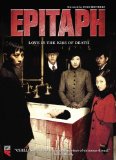| Reviews & Columns |
|
Reviews DVD TV on DVD Blu-ray 4K UHD International DVDs In Theaters Reviews by Studio Video Games Features Collector Series DVDs Easter Egg Database Interviews DVD Talk Radio Feature Articles Columns Anime Talk DVD Savant Horror DVDs The M.O.D. Squad Art House HD Talk Silent DVD
|
DVD Talk Forum |
|
|
| Resources |
|
DVD Price Search Customer Service #'s RCE Info Links |
|
Columns
|
|
|
Epitaph
TLA Releasing // Unrated // February 24, 2009
List Price: $19.99 [Buy now and save at Amazon]
The Film:
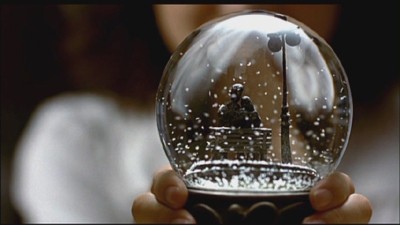 As a long-running admirer of the Asian horror genre, from twisted little treats like Korea's Cello and Thailand's Shutter to classic Japanese stuff like Kwaidan and Ugetsu, its hard not to collide with a few entries suffering from a bit of the Yasujiro Ozu complex -- you know, feeling like it's similar to the rest even though the plot and characters differ greatly. Epitaph, a formula-laden Korean ghost tale from first-time writer/directors the Jung Brothers, happens to be one. Beautiful agony on the eyes yet discombobulating and familiar as a heartbeat, it cherry picks genre element after played-out genre element and crams them all into a drudgingly-paced two hours.
As a long-running admirer of the Asian horror genre, from twisted little treats like Korea's Cello and Thailand's Shutter to classic Japanese stuff like Kwaidan and Ugetsu, its hard not to collide with a few entries suffering from a bit of the Yasujiro Ozu complex -- you know, feeling like it's similar to the rest even though the plot and characters differ greatly. Epitaph, a formula-laden Korean ghost tale from first-time writer/directors the Jung Brothers, happens to be one. Beautiful agony on the eyes yet discombobulating and familiar as a heartbeat, it cherry picks genre element after played-out genre element and crams them all into a drudgingly-paced two hours.
Stop me if you've heard this one before: long, dark-haired women torment people in a cramped, eerie environment with a tumultuous past. Epitaph's location, however formulaic, is a deliciously ominous Korean hospital in the '40s, one filled with students, snails, and lots and lots of blood. This once-shut-down hospital happens to be home to a harrowing accident involving a botched brain surgery on an army official, all captured through-black-and-white footage at the beginning of the film that will certainly come to "use" for its audience as things progress. Years later, this place still lugs around its secrets -- some that the students discover on their own through patients, both living and deceased, and some that the doctors involved in the accident must endure. Focusing on a key theme, a student asks one of his teachers whether they "believe in ghosts", which works kind of like striking a piano chord in the film since this idea's vibrations rumble until the note fades away.
Challenging the line between aesthetic storytelling and stilted narrative, Epitaph easily satisfies in the blood and beauty part of the equation. It's obvious that photographer Youn Nam-joo was at least mildly influenced by Kim Ji-woon's A Tale of Two Sisters, as the playfulness with fluctuating, deep palettes feels very proverbial. Yet there are plenty of visual elements that strike true within these familiar surroundings, such as the gorgeous capturing of a wooden-door morgue in the film's most entrancing scene. Now, the murky water running out of comes eerily close to being reminiscent of ... well, Dark Water, but the graceful movement to and fro and the gentle scattering of flower petals create something beautiful out of an unnerving scenario.
That's just one example of many; The Jung Brothers concentrate heavily on encircling their audience with visceral enrichment by dropping familiar found objects in haunting locations, such as a snow globe and a hairpin with a butterfly on the opposite end. Once they lure you into the somewhat calming darkness and have you darting glances around at shiny nuggets of symbolism, then they lay the gore on. There's plenty of the red stuff, all pieced together through phenomenal production design. Epitaph finds a way to capture gore in a disquieting fashion, certainly causing stomachs to churn but also keeping in mind that they want their audience to be swimming in their story.
But there's the problem: the array of stories intermingled within Epitaph's striking visuals are a complete mess. It's not unlike Three Extremes in that the three tales -- the boy entranced by a dead girl's corpse, the young girl in a driving accident, and the doctor couple whom one of which doesn't have a shadow -- share a cohesiveness that's just a step above episodic, only these stories all take place within one location. It would be one thing if they were original and tightly-written, but there's such indistinctness about this over-ambitious script that they just blend in with the rest of the genre's weathered blueprints.
Epitaph literally feels like you're watching several of your favorite Asian horror films all looped simultaneously in the background of a Korean/Japanese language medical drama, throwing in cues from some of the aforementioned films like A Tale of Two Sisters and Dark Water with added squeezes of Uzumaki, a slathering of Takashi Miike-like tones (especially his Three Extremes segment), and an undeniable similarity to Cello's style of flip-flopping tension. Hell, even some of Alfred Hitchcock's Psycho seeps into the picture, in instantly recognizable fashion. The only thing distinct about Epitaph, the one thing that partitions it from its predecessors, is its effortless upstaging in cinematography and blood-dipped production work, while the rest plays it safe and goes for run-of-the-muck supernatural terror -- which does stir some genuine chills.
Though it's not likely that you'll find much better in the atmosphere and photography departments, the Jung Brothers get a bit sloppy when they try to dazzle with an onslaught of twists and turns near their countless, time-oblivious conclusions... plural, conclusions. Easily twenty minutes too long, their picture has perfect moments to close up its twisting, somewhat entrancing narrative, but then it goes on to repeatedly take stabs at wrapping up the story more and more. They knew that they're treading in familiar territory and have a lot of loose ends to tie up, which shows by their persistence to give closure to their picture. As with the narrative's rhythm, these endings too feel like punchlines for jokes heard many times over. Epitaph delivers a lavish horror framework in the same lineage as its influences, but the edge is too dull and overplayed to dig in too deep.
The DVD:
Video and Audio:
Released under TLA's Danger After Dark label, Epitaph arrives in a suitable 1.85:1 anamorphic widescreen image. Now, some mild aliasing and macroblocking do crop up at a few spots, as well as a few ghosting issues. But there are a few other patches, such as a wide array of close-ups and tactile shots, that show off plenty of detail and dimensionality. Black levels generally stay strong -- especially during the haunting morgue scene -- though some do lean on the purplish/grayish side. There's also a general haze about the entire image, rendering it a somewhat out of focus feel that can be distracting at a few times, as well as a bit of print damage. But color richness rarely ever wavers, pouring through both mildly desaturated palettes and bold splashes of color in strong fashion. It's a fine-looking transfer that stands up to the job of presenting a sumptuously visual horror film in decent fashion.
Staying true to the course, the Korean/Japanese 5.1 track is fairly front-heavy and non-dimensional, but it stays pretty crisp and clear throughout. A few sound effects touch in the upper levels of the sound experience, but this is largely a docile aural treatment. Ambiance is the key factor, from trickling water to stabbing sounds, which all stay very stable and audible. Moreover, verbal clarity stays clean as well, never growing too raspy -- though there are really no instances in this whispering picture where it gets tested to any extravagant degree. Subtitles in English, exceedingly good ones in fact, are optional to accompany the sole Dolby 5.1 track.
Special Features:
As far as extras go, all we've got is a Danger After Dark Trailer for Epitaph, a Photo Gallery, and a few other TLA Releasing Trailers.
Final Thoughts:
Picture Epitaph as a shopping basket, and the Asian horror film genre as a farmer's market. It shuffles around and picks up all the right ingredients from other sources to make its own recipe, but something went awry during its conception. It suffers from scatterbrained storytelling issues that make it harder to dive into the picture -- yet, oddly, place stronger emphasis on the strong photography and exceptional make-up and production work. Thankfully, it's still a gorgeous, gruesome dish that's worth a Rental; however, if you haven't had the chance to see some of the pictures listed in this review -- namely lesser-seen, lesser appreciated ones like Uzumaki or Cello -- or even other chilling slow-burners like the medically-minded Vital or Danger After Dark's own Strange Circus, then go those routes first.
Thomas Spurlin, Staff Reviewer -- DVDTalk Reviews | Personal Blog/Site
 As a long-running admirer of the Asian horror genre, from twisted little treats like Korea's Cello and Thailand's Shutter to classic Japanese stuff like Kwaidan and Ugetsu, its hard not to collide with a few entries suffering from a bit of the Yasujiro Ozu complex -- you know, feeling like it's similar to the rest even though the plot and characters differ greatly. Epitaph, a formula-laden Korean ghost tale from first-time writer/directors the Jung Brothers, happens to be one. Beautiful agony on the eyes yet discombobulating and familiar as a heartbeat, it cherry picks genre element after played-out genre element and crams them all into a drudgingly-paced two hours.
As a long-running admirer of the Asian horror genre, from twisted little treats like Korea's Cello and Thailand's Shutter to classic Japanese stuff like Kwaidan and Ugetsu, its hard not to collide with a few entries suffering from a bit of the Yasujiro Ozu complex -- you know, feeling like it's similar to the rest even though the plot and characters differ greatly. Epitaph, a formula-laden Korean ghost tale from first-time writer/directors the Jung Brothers, happens to be one. Beautiful agony on the eyes yet discombobulating and familiar as a heartbeat, it cherry picks genre element after played-out genre element and crams them all into a drudgingly-paced two hours. Stop me if you've heard this one before: long, dark-haired women torment people in a cramped, eerie environment with a tumultuous past. Epitaph's location, however formulaic, is a deliciously ominous Korean hospital in the '40s, one filled with students, snails, and lots and lots of blood. This once-shut-down hospital happens to be home to a harrowing accident involving a botched brain surgery on an army official, all captured through-black-and-white footage at the beginning of the film that will certainly come to "use" for its audience as things progress. Years later, this place still lugs around its secrets -- some that the students discover on their own through patients, both living and deceased, and some that the doctors involved in the accident must endure. Focusing on a key theme, a student asks one of his teachers whether they "believe in ghosts", which works kind of like striking a piano chord in the film since this idea's vibrations rumble until the note fades away.
Challenging the line between aesthetic storytelling and stilted narrative, Epitaph easily satisfies in the blood and beauty part of the equation. It's obvious that photographer Youn Nam-joo was at least mildly influenced by Kim Ji-woon's A Tale of Two Sisters, as the playfulness with fluctuating, deep palettes feels very proverbial. Yet there are plenty of visual elements that strike true within these familiar surroundings, such as the gorgeous capturing of a wooden-door morgue in the film's most entrancing scene. Now, the murky water running out of comes eerily close to being reminiscent of ... well, Dark Water, but the graceful movement to and fro and the gentle scattering of flower petals create something beautiful out of an unnerving scenario.
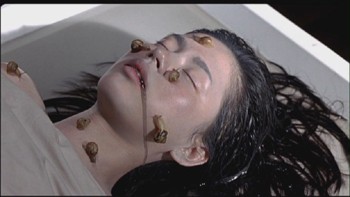 | 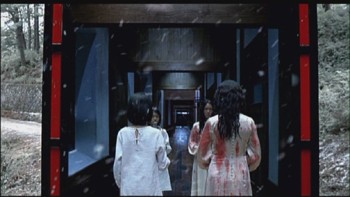 |
That's just one example of many; The Jung Brothers concentrate heavily on encircling their audience with visceral enrichment by dropping familiar found objects in haunting locations, such as a snow globe and a hairpin with a butterfly on the opposite end. Once they lure you into the somewhat calming darkness and have you darting glances around at shiny nuggets of symbolism, then they lay the gore on. There's plenty of the red stuff, all pieced together through phenomenal production design. Epitaph finds a way to capture gore in a disquieting fashion, certainly causing stomachs to churn but also keeping in mind that they want their audience to be swimming in their story.
But there's the problem: the array of stories intermingled within Epitaph's striking visuals are a complete mess. It's not unlike Three Extremes in that the three tales -- the boy entranced by a dead girl's corpse, the young girl in a driving accident, and the doctor couple whom one of which doesn't have a shadow -- share a cohesiveness that's just a step above episodic, only these stories all take place within one location. It would be one thing if they were original and tightly-written, but there's such indistinctness about this over-ambitious script that they just blend in with the rest of the genre's weathered blueprints.
Epitaph literally feels like you're watching several of your favorite Asian horror films all looped simultaneously in the background of a Korean/Japanese language medical drama, throwing in cues from some of the aforementioned films like A Tale of Two Sisters and Dark Water with added squeezes of Uzumaki, a slathering of Takashi Miike-like tones (especially his Three Extremes segment), and an undeniable similarity to Cello's style of flip-flopping tension. Hell, even some of Alfred Hitchcock's Psycho seeps into the picture, in instantly recognizable fashion. The only thing distinct about Epitaph, the one thing that partitions it from its predecessors, is its effortless upstaging in cinematography and blood-dipped production work, while the rest plays it safe and goes for run-of-the-muck supernatural terror -- which does stir some genuine chills.
Though it's not likely that you'll find much better in the atmosphere and photography departments, the Jung Brothers get a bit sloppy when they try to dazzle with an onslaught of twists and turns near their countless, time-oblivious conclusions... plural, conclusions. Easily twenty minutes too long, their picture has perfect moments to close up its twisting, somewhat entrancing narrative, but then it goes on to repeatedly take stabs at wrapping up the story more and more. They knew that they're treading in familiar territory and have a lot of loose ends to tie up, which shows by their persistence to give closure to their picture. As with the narrative's rhythm, these endings too feel like punchlines for jokes heard many times over. Epitaph delivers a lavish horror framework in the same lineage as its influences, but the edge is too dull and overplayed to dig in too deep.
The DVD:
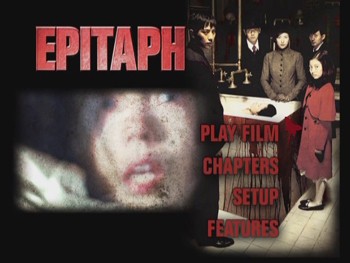 | 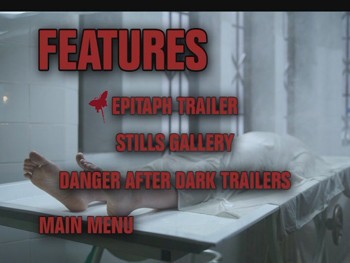 |
Video and Audio:
Released under TLA's Danger After Dark label, Epitaph arrives in a suitable 1.85:1 anamorphic widescreen image. Now, some mild aliasing and macroblocking do crop up at a few spots, as well as a few ghosting issues. But there are a few other patches, such as a wide array of close-ups and tactile shots, that show off plenty of detail and dimensionality. Black levels generally stay strong -- especially during the haunting morgue scene -- though some do lean on the purplish/grayish side. There's also a general haze about the entire image, rendering it a somewhat out of focus feel that can be distracting at a few times, as well as a bit of print damage. But color richness rarely ever wavers, pouring through both mildly desaturated palettes and bold splashes of color in strong fashion. It's a fine-looking transfer that stands up to the job of presenting a sumptuously visual horror film in decent fashion.
Staying true to the course, the Korean/Japanese 5.1 track is fairly front-heavy and non-dimensional, but it stays pretty crisp and clear throughout. A few sound effects touch in the upper levels of the sound experience, but this is largely a docile aural treatment. Ambiance is the key factor, from trickling water to stabbing sounds, which all stay very stable and audible. Moreover, verbal clarity stays clean as well, never growing too raspy -- though there are really no instances in this whispering picture where it gets tested to any extravagant degree. Subtitles in English, exceedingly good ones in fact, are optional to accompany the sole Dolby 5.1 track.
Special Features:
As far as extras go, all we've got is a Danger After Dark Trailer for Epitaph, a Photo Gallery, and a few other TLA Releasing Trailers.
Final Thoughts:
Picture Epitaph as a shopping basket, and the Asian horror film genre as a farmer's market. It shuffles around and picks up all the right ingredients from other sources to make its own recipe, but something went awry during its conception. It suffers from scatterbrained storytelling issues that make it harder to dive into the picture -- yet, oddly, place stronger emphasis on the strong photography and exceptional make-up and production work. Thankfully, it's still a gorgeous, gruesome dish that's worth a Rental; however, if you haven't had the chance to see some of the pictures listed in this review -- namely lesser-seen, lesser appreciated ones like Uzumaki or Cello -- or even other chilling slow-burners like the medically-minded Vital or Danger After Dark's own Strange Circus, then go those routes first.
|
| Popular Reviews |
| Sponsored Links |
|
|
| Sponsored Links |
|
|
| Release List | Reviews | Shop | Newsletter | Forum | DVD Giveaways | Blu-Ray | Advertise |
|
Copyright 2024 DVDTalk.com All Rights Reserved. Legal Info, Privacy Policy, Terms of Use,
Manage Preferences,
Your Privacy Choices | |||||||









